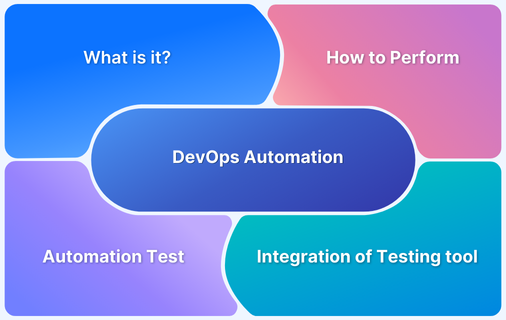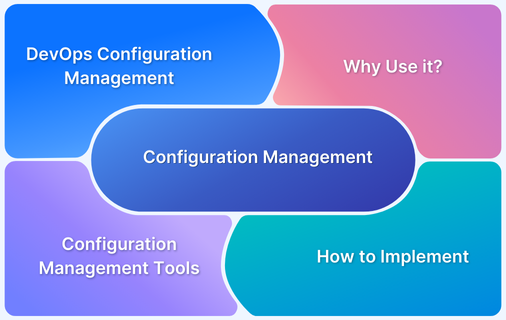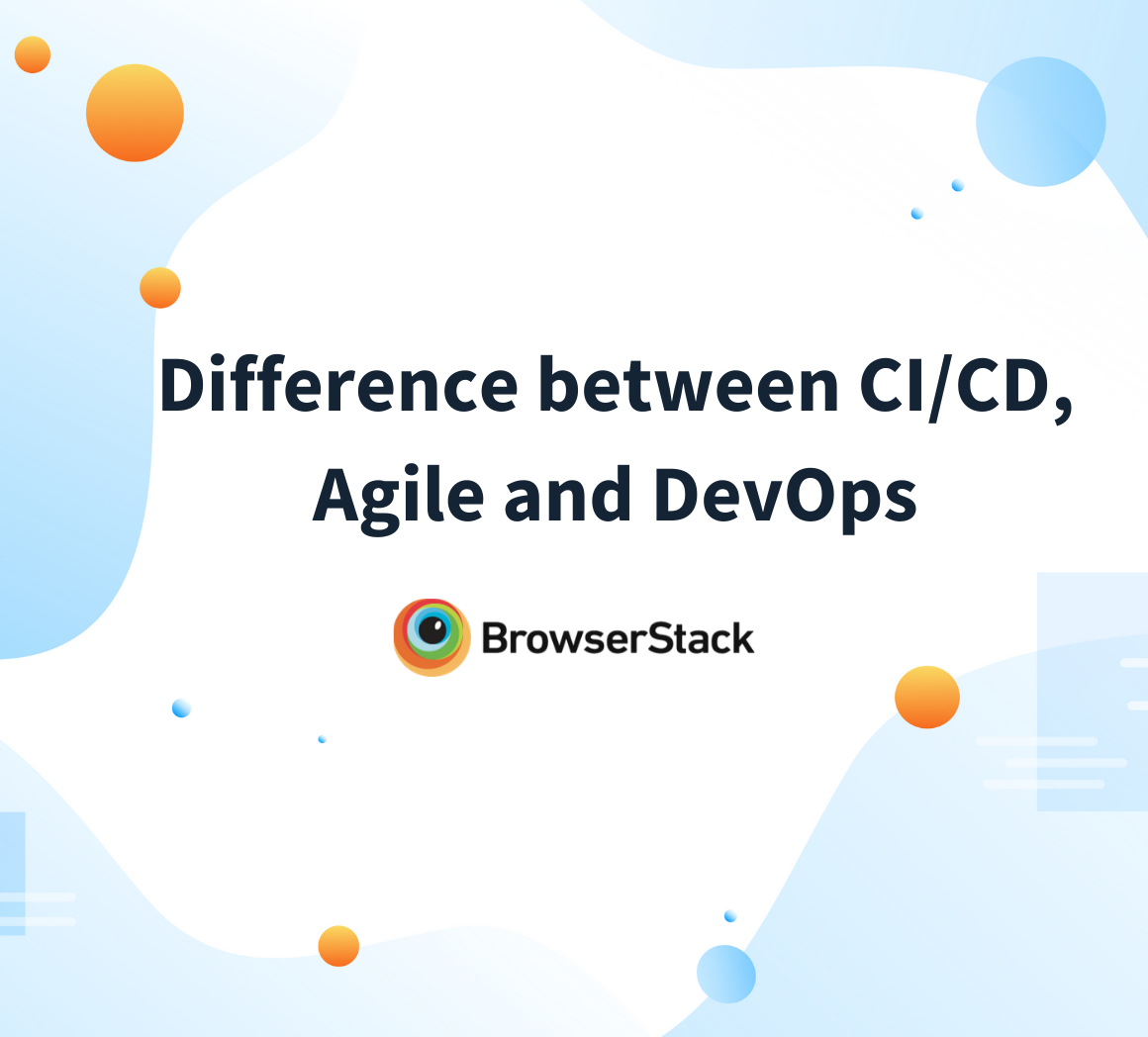DevOps is an amalgamation of various tools, working methodologies, and practices designed to enhance the efficiency of the software development lifecycle. DevOps Automation improves the efficiency of DevOps by employing software tools to make repetitive processes in DevOps more efficient.
Overview
What is DevOps Automation?
DevOps automation involves using tools and scripts to automate repetitive tasks in the software development and operations lifecycle, enhancing efficiency and reducing errors.
Why is DevOps Automation Needed?
It accelerates delivery cycles, improves reliability, reduces manual effort, and ensures consistency across processes, enabling teams to meet evolving business demands.
Which DevOps Processes can be Automated?
Processes like infrastructure provisioning, CI/CD pipelines, testing, monitoring, and configuration management can be automated for efficiency.
Benefits of DevOps Automation
- Faster delivery cycles
- Improved scalability and reliability
- Reduced operational costs
- Enhanced collaboration and transparency
This guide describes DevOps Automation, its benefits, how to perform it, and why a DevOps tool should be integrated with a testing tool.
What is DevOps Automation?
DevOps Automation refers to the use of tools and technology to automate repetitive, time-consuming, and manual tasks within the DevOps lifecycle. It streamlines software development, testing, deployment, and infrastructure management. DevOps automation enables teams to deliver high-quality software faster and with greater consistency.
The main benefits of DevOps automation are:
- Faster Delivery: Automation accelerates workflows, reducing delays caused by manual processes.
- Consistency: Eliminates human error, ensuring repeatable and reliable processes.
- Scalability: Automates infrastructure and deployment processes to handle growing demands efficiently.
Why is DevOps Automation needed?
Automation is vital in DevOps as it enhances efficiency, standardizes processes, and minimizes risks. Here’s why it matters:
1. Eliminates Redundancy
Automation removes repetitive tasks, like code deployment or system configuration, reducing errors and ensuring consistency. By standardizing processes, it boosts efficiency and eliminates the need for manual repetition of tasks.
2. Establishes Clear Guidelines
DevOps automation provides standardized workflows. Clear prescriptions for each stage of the development cycle improve collaboration and communication and reduce ambiguity between teams.
3. Reduces Risks
Automating testing, integration, and deployment processes minimizes human error, detects issues early, and ensures smoother software releases. It enhances system stability and reliability throughout the pipeline.
Also Read: Guide to DevOps Automation Testing
Which DevOps Processes can be Automated?
Here are the different types of DevOps Automation
- Infrastructure as Code (IaC): Automates the provisioning and management of infrastructure through code, ensuring consistency, scalability, and repeatability across environments.
- Configuration Management: Automates the configuration and maintenance of systems, ensuring uniform setup and updates across all environments to reduce errors.
- Continuous Integration (CI): Automate the integration of code changes into a shared repository with tools like Jenkins, GitLab CI/CD, or CircleCI.
- Continuous Delivery (CD): Automate the deployment of code to staging or production environments, ensuring faster and more reliable releases.
- Continuous Testing: Automates testing at every stage of the DevOps pipeline, ensuring continuous quality checks and faster identification of defects before deployment.
- Continuous Monitoring: Automates the tracking of system performance, health, and security to proactively identify and resolve issues, ensuring system reliability and stability.
Benefits of DevOps Automation
Here are the benefits of implementing DevOps Automation:
- Faster Delivery Cycles: Automation speeds up development, testing, and deployment, reducing time-to-market.
- Improved Quality: Automated testing and monitoring ensure higher software quality and fewer defects.
- Scalability: Easily adapt to growing infrastructure and team needs without increasing manual effort.
- Consistency and Reliability: Automating processes ensures uniformity, minimizing human error.
- Cost Efficiency: Reduces manual labor and operational overheads.
- Enhanced Collaboration: Teams can focus on value-added tasks, fostering better communication and alignment.
- Proactive Issue Resolution: Continuous monitoring detects and resolves issues before they impact users.
Read More: DevOps Testing Strategy
How to perform DevOps Automation
DevOps encompasses various processes and not all of them can be automated. It’s essential to choose the appropriate processes to automate at the beginning of any software project.
Following are some of the processes that an be best optimized through automation:
1. Planning Phase
It’s imperative to establish a requirements document, and sketch out a plan for the development of the software. This phase is the time DevOps teams use to ideate and decide the features and functions of the software they plan to build, make decisions such as choosing performance metrics, and lastly take feedback from all stakeholders.
At this phase tools such as GitLab, Atlassian, Jira, GitHub, and Azure DevOps can be used to automate certain tasks such as:
- Gathering Stakeholder Feedback
- Issue tracking
- Organizing Information and Prioritizing actions
- Visualizing Progress with Dashboards.
2. Coding Phase
This phase involves the creation and design of software code to fulfill the requirements decided upon during the planning phase.
During this phase it’s imperative to use a source code repository to collaborate and keep track of all code, to review code, and to perform corrections as needed.
At this phase tools such as GitHub, BitBucket, and GitLab can be used to automate certain tasks such as:
- Repetitive manual tasks in code development.
- Code review.
3. Build Phase
In this phase code submitted to the source code repository is compiled and built into artifacts which are executable in different environments. Following this automated unit and regressions tests are run to ensure the code is functional and suitable to be deployed.
The decided performance metrics are used to measure the quality of the code, its performance, its functionality, and other traits prior to release.
At this phase tools such as GitLab, GitHub, Docker, Puppet, Gradle, and CFEngine are employed to automate tasks such as:
- Building the code into executable artifacts.
- Generating statistics.
- Containerized environment creation.
- Generating demo web pages and documentation.
- Automating the iterative testing and review process.
4. Test Phase
This phase involves continuous testing to detect any bugs or defects, validate the code, and ensure that its acceptable according to the requirements document. Quality assurance is also carried out at this stage to verify and approve the code for integration and deployment.
At this phase tools such as Selenium, Cucumber, JUnit, and TestNG are employed to automate tasks such as:
- Automating unit tests and acceptance and regression testing, security and vulnerability analysis, configuration testing, and performance measurement.
- Prioritization and allocation of errors found.
Also Read: Test Case Prioritization: A Detailed Guide
5. Release and Deployment Phase
Once the software or updated feature has passed the Testing Phase and all requirements have been met it can then be deployed. In the case that a new or updated feature is being released the teams will often ensure that back-ups are available in case something goes wrong and then deploy the feature.
During this Phase staging of the release is carried out as well. This step is penultimate to the deployment of the new features/live website. This staging environment is a replica of the live website and the last step where the DevOps team and other stakeholders can test the quality in a production-like environment prior to deployment.
At this phase tools such as Jenkins, AWS CodePipeline, Ansible, Chef, Kubernetes, CircleCI, Docker, and Jira are employed to automate tasks such as:
- Managing, scheduling, and coordinating various feature releases into the live website.
- Network, Data storage, and general configuration management to optimize performance.
6. Operations and Monitoring Phase
Once the software/feature has been deployed it is important to monitor the server and performance of the software to understand the impression it has on its users and to flag incidents early. Continuous feedback from users is also taken in order to continuously improve the application and keep it relevant.
At this phase tools such as Slack, Splunk, Wireshark, Sumo Logic, pendo, and pingdom are employed to automate tasks such as:
- Automation tools that can monitor availability, performance, or security problems and generate alerts based on them help solve this challenge.
- Application monitoring
- Security monitoring
- Alert generation for any incidents or errors
- Monitoring the availability of the software
- Collecting user metrics and feedback
- Creating Visuals for User and Performance Metrics
How Automation Testing fits into DevOps?
Automation testing plays an important role in the DevOps lifecycle, bridging the gap between development and operations by ensuring rapid, reliable, and continuous testing of software. Here is how it fits into DevOps:
- Supports CI/CD Pipelines: Automation testing integrates seamlessly into Continuous Integration/Continuous Deployment (CI/CD) pipelines, allowing for automatic execution of test cases whenever new code is committed or deployed, ensuring that issues are identified early and resolved quickly without slowing down the pipeline.
- Enables Shift-Left Testing: DevOps emphasizes early testing in the development cycle (Shift-Left Testing). Automation testing empowers teams to test code as it’s written, ensuring that defects are caught early reducing the cost and effort required to fix them.
- Accelerates Feedback Loops: Automation testing provides immediate feedback to developers and operations teams about the quality of the code. Faster feedback loops improve collaboration, help detect issues in real-time, and support rapid decision-making.
- Maximizes Test Coverage and Consistency: Automated test suites can run across multiple environments, platforms, and configurations in parallel. This ensures thorough test coverage, minimizes human error, and maintains consistency in results.
- Facilitates Continuous Testing: In DevOps, testing is not a one-time activity but a continuous process. Automation testing ensures continuous validation of code changes throughout the lifecycle, from development to production.
- Integrates with Monitoring and Reporting: Automation testing tools often integrate with monitoring and reporting platforms to provide actionable insights. These insights help teams track progress, identify bottlenecks, and measure test effectiveness.
Tools for DevOps Automation
Here are the top tools for DevOps Automation:
- Terraform: Automates infrastructure provisioning and management with Infrastructure as Code (IaC).
- Ansible: Simplifies configuration management, deployment, and task automation.
- Jenkins: Automates code integration, builds, and deployments for CI/CD workflows.
- GitLab CI/CD: Integrates version control and CI/CD pipelines to streamline development and delivery.
- Puppet: Manages infrastructure configuration for consistent environments.
- Docker: Packages applications into containers for seamless deployment and scalability.
- Kubernetes: Orchestrates containerized applications for automated scaling and management.
- Prometheus: Monitors system performance and generates real-time alerts.
- SonarQube: Ensures code quality and security through automated static code analysis.
- ELK Stack (Elasticsearch, Logstash, Kibana): Analyzes and visualizes logs for actionable insights.
- BrowserStack: Provides continuous testing on real devices and browsers, ensuring software quality in DevOps pipelines.
- Nagios: Monitors systems and applications to ensure high availability and reliability.
- PagerDuty: Automates incident response and resolution tracking for better reliability.
- Chef: Automates server configurations for consistent infrastructure setups.
- Snyk: Identifies and fixes security vulnerabilities in code dependencies.
Why integrate DevOps Automation tool with Testing Tool?
Integrating DevOps automation tools with testing tools streamlines workflows, ensuring efficient validation of builds and deployments in CI/CD pipelines. Automated tests can be triggered at every stage, enabling early defect detection and reducing the time and cost of fixing issues. Continuous testing becomes achievable, allowing quality checks to run throughout the development lifecycle.
Providing real-time test results and insights helps create faster feedback loops and ensures alignment among all stakeholders.
BrowserStack simplifies this integration with its comprehensive suite of testing tools. It enables DevOps teams to implement continuous testing for web and mobile applications. With features like cross-browser testing, real device cloud access, and test management tools, BrowserStack supports DevOps teams in delivering reliable, high-quality software faster.
BrowserStack’s unified reporting and monitoring through integrated platforms provide actionable insights, enabling teams to optimize workflows and make data-driven decisions.
Best Practices for DevOps Automation
Here are some of the best practices for DevOps Automation:
- Start Small and Scale Gradually: Automate repetitive, high-impact tasks first, and expand automation as the process evolves.
- Implement Infrastructure as Code (IaC): Use tools like Terraform to standardize and simplify infrastructure provisioning.
- Adopt Continuous Integration and Delivery (CI/CD): Automate code integration, testing, and deployments to accelerate and streamline releases.
- Prioritize Continuous Testing: Leverage tools like BrowserStack to ensure automated quality checks at every pipeline stage.
- Use Version Control for Everything: Store code, configurations, and scripts in Git to track changes and enable easy rollbacks.
- Monitor and Optimize: Continuously track system performance with tools like Prometheus to identify and resolve issues proactively.
- Standardize Tools and Processes: Ensure consistency by using the same tools and workflows across teams.
- Focus on Security Automation: Integrate tools like Snyk to detect and address vulnerabilities early in the pipeline.
- Encourage Collaboration: Align development, operations, and QA teams to improve automation outcomes and communication.
- Regularly Review and Update Automation: Periodically evaluate and refine processes to maintain efficiency and relevance.
Useful Resources for DevOps
Understanding DevOps:
- What is DevOps
- DevOps Shift Left Testing: A Detailed Guide
- What is the ultimate goal of DevOps?
- Benefits of DevOps
- What is DevOps Configuration Management?
- What is Continuous Delivery in DevOps?
- What is a DevOps Pipeline? How to Build One
- What is DevOps Observability (Importance & Best Practices)
- DevOps Testing Strategy
- How to improve DevOps Feedback Loop
- Python For DevOps: An Ultimate Guide
- What is DevOps Automation and How is it Helpful?
- Importance of DevOps Team Structure
- The Role of QA in DevOps
- Top Challenges in DevOps and How to Solve Them
- Top 21 Monitoring Tools in DevOps for 2024
Know the difference:
- DevOps vs Scrum: Key Differences
- Breaking Down MLOps vs DevOps: Similarities and Differences
- DevOps vs SysOps: What are the major differences
- DataOps vs DevOps: Key Differences
- TechOps, DevOps, and NoOps: Which one is right for you?
- DevOps vs CloudOps: How are they different
- DevOps Engineer vs Full Stack Developer: Differences
- Synchronize Business Analysis, DevOps, and QA with Cloud Testing
Conclusion
Automated DevOps is essential for achieving speed, agility, and reliability. Organizations can accelerate delivery cycles, improve software quality, and adapt quickly to changing requirements by automating repetitive tasks and integrating testing into the DevOps pipeline.
Automated testing is the foundation for achieving an overall automated DevOps pipeline. It ensures that quality checks are integrated into every phase of the software development lifecycle.
Therefore, integrating DevOps tools with automation testing tools like BrowserStack Automate and App Automate is recommended. BrowserStack’s Cloud Selenium Grid simplifies testing by enabling parallel automation tests on 3500+ real device/browser/OS combinations. This speeds up the testing processes and ensures consistent user experiences across all releases.






